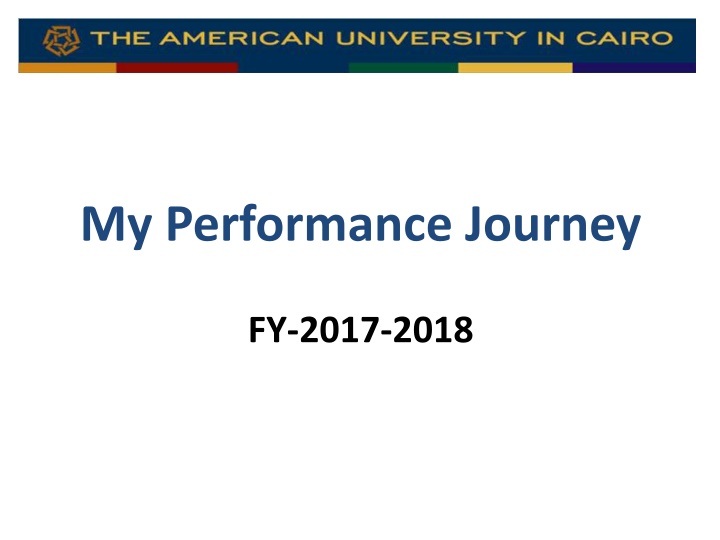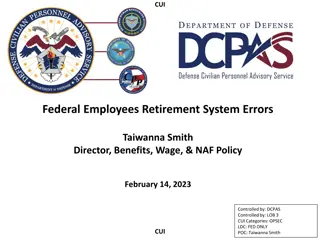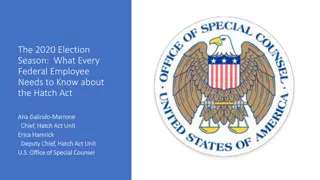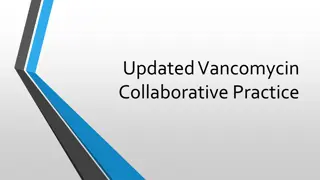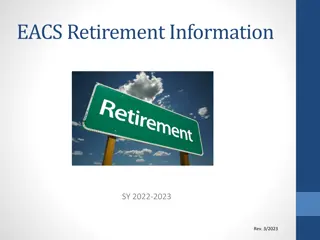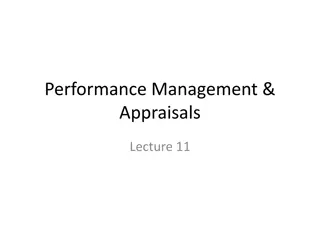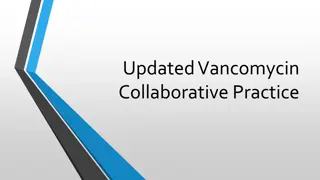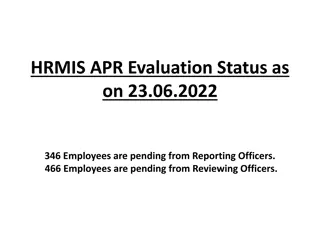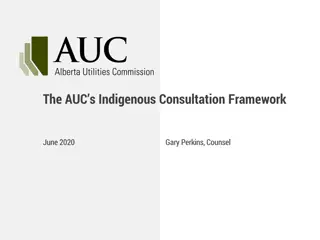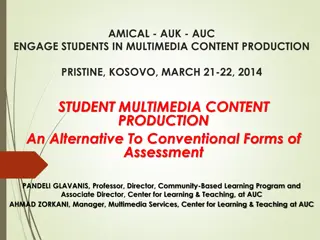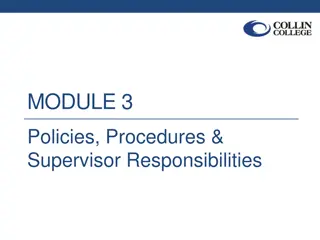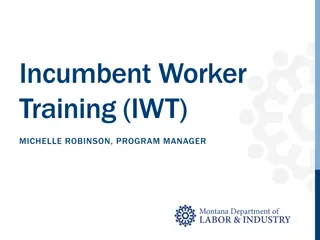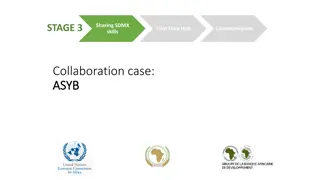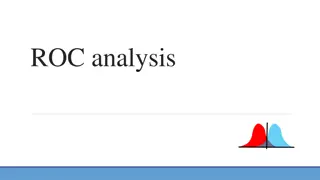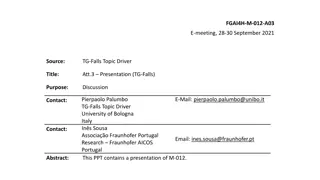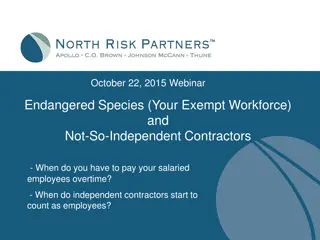Performance Journey FY 2017-2018 at AUC: Engaging Employees for Growth
AUC's Community Vision focuses on engaging employees for purposeful learning and growth, with a strong emphasis on performance-based culture, development tools, and constructive review sessions. The Performance Journey Objective Cycle includes elements like the Employee Annual Scorecard and Individual Development Plan, stressing the importance of personal development objectives and competencies assessment. The Scorecard Elements outline various objectives related to business performance, personal performance, role-specific tasks, strategic initiatives, and job enrichment. Overall, the focus is on aligning individual goals with the University's strategic objectives to foster collaboration and enhance employee skills and competencies.
Download Presentation

Please find below an Image/Link to download the presentation.
The content on the website is provided AS IS for your information and personal use only. It may not be sold, licensed, or shared on other websites without obtaining consent from the author.If you encounter any issues during the download, it is possible that the publisher has removed the file from their server.
You are allowed to download the files provided on this website for personal or commercial use, subject to the condition that they are used lawfully. All files are the property of their respective owners.
The content on the website is provided AS IS for your information and personal use only. It may not be sold, licensed, or shared on other websites without obtaining consent from the author.
E N D
Presentation Transcript
My Performance Journey FY-2017-2018
Our Community Vision: To assure all AUC employees are engaged, stretched and challenged to learn and grow purposefully; making a difference while taking ownership of their professional journey. My Performance Journey Focuses on: Creating an efficient performance based community focused on performance, values and competencies Focusing on tools of development of our employees (e.g., Coaching, Mentorship and Leadership Programs) Holding constructive review sessions to support our employees in meeting their objectives Holding formal semi-annual reviews (developmental, not evaluative) Evaluating employee overall performance by year-end Ensuring consistency in performance assessment across the University (clear, consistent and robust performance objectives to align with the University s strategic objectives)
Performance Journey Objective Cycle Elements of Employee Annual Scorecard: Individual Development Plan Department s strategic objective Performance in Role + Strategic initiatives Job Enrichment (Personal Development) Values/Competencies framework The Individual Development Plan (IDP) section is open in this cycle to ensure all employees have an IDP The 1 or 2 most critical development areas shall be added by the employee as Personal Development Objective(s).
Scorecard Elements Number of objectives Example of Objective Philosophy Business Performance ~1 -2 Dept. Overall Yearly Objective The Department overall objectives linked to the University overall strategic objectives Linked to underlying department performance to foster cross functional collaboration Personal Performance ~4-6 Launch a new process or initiative in own role that would enhance workflow Achieve successful executive recruitment Roll out a branding initiative to enhance the brand value of AUC Role Specific: Related to the job holder core responsibilities and delivery - They are measures of success in role Strategic Initiatives: related to taking initiatives on the job but not necessarily part of the day-to-day deliverables Performance in Role ~1-2 Improve overall business understanding through getting exposure to cross functional projects Improve modelling skills Job Enrichment (Personal Development) Specific personal development objectives related to enhancing business functional skills and/or Competencies model behaviors Competencies Assessment According to a predetermined set. Instill AUC core competencies
Business Performance A Closer Look! Improving an individual s performance within his/her department is a mutual responsibility. The Senior Executive, the Manager and the Employee are all responsible in this objective, and it is important to clearly understand the roles of each. One of the most important aspects of the leadership s responsibility is developing and communicating the Strategic Objectives that the employees will aim to help accomplish FY18 Strategic Initiative is : Institutional Effectiveness
Setting Objectives Managers and employees need to collaborate in setting meaningful goals/ objectives tracking progress against those goals throughout the year, and evaluating performance. Connecting an employee s work with University goals is the top driver of accountability. Procedures: 1. Employee and Manager meet to discuss department objectives and ensure: Alignment of objectives with those of peers and the department. Objectives support the employee s personal development goals. 2. Employee submits the agreed objectives (Role specific , Strategic, Job Enrichment Personal Development ) in the My Performance Journey online form based on the discussion with his/her Manager.
Setting SMARTER Objectives Objectives should be AMBITIOUS Employee should push the bar and make sure objectives reflect business priorities, department overall vision and mission in line with the University Strategic Objective. Use the SMARTER method when defining objectives: Specific State exactly what shall be accomplished (who, what, where and why). Measurable Define how to demonstrate and evaluate the extent to which the goal was met. Achievable Set objectives that can be realistically achieved. Relevant Define objectives that are relevant for the role and the success of the business. Time bound Objectives should have an end date and be achievable within the specified time frame. Evaluate Evaluate your goals regularly to make sure you are on track to completing them. Readjust Readjust your approach if needed to make sure you are still taking the best way forward.
Rating Scale Rating Definition Performance at this level far exceeds expectations. A mark at this level represents a level of performance that is rare and unusual. In determining what is rare and unusual, it is important to rely on actual events. An appraisal at this level requires thorough documentation, notes, and remarks. Outstanding: This is "very good" performance that exceeds expectations, but not to the extent that it would be considered rare and unusual. Performance at this level makes a positive difference to the University in a way that is important, understood, and accepted by the manager, the employee and, where applicable, coworkers. Very Good: This is good/acceptable performance on the level expected from a trained, experienced, and successful employee. Successful: This mark is given when performance falls somewhat short of what is expected. This level indicates the need for continued training to improve to the Successful level within a reasonable period of time (Up to 6 months). Needs Improvement:
Success Factors Quick Guide AUC Online Performance Management Platform
Success Factors Quick Guide AUC Online Performance Management Platform
Success Factors Quick Guide AUC Online Performance Management Platform
Performance Management System Cycle FY-19 (Complete Cycle) FY-18 (Short Cycle) December May/Jun e July Dec/Jan Oct/Nov May Prepare for mid- year development review Development dialogue: conduct mid-year check-in (share feedback, progress on individual development plan and realign objectives if necessary) Goal Settings Launching the PMS Awareness Sessions to staff Self reflection for year-end review First performance conversation: Discuss self reflection with Line Manager Manager prepares perspective on performance and potential development plan after reviewing all facts and adding Self reflection for year-end review First performance conversation: Discuss self reflection with line manager Manager prepares perspective on performance and potential development plan after reviewing all facts and adding Target setting: Agree on annual objectives and individual development plans
Employee Scorecard in relation to Merit Increase, Recognition program , Promotions and Development Plan: Our Employee Scorecard serves two distinct but interlinked purposes: 1. Merit increase will be based both on areas of direct influence/responsibility (personal performance) and areas of shared responsibility (business performance). Merit Increase Personal Performance Business Performance Relevant Job Performance in role + Strategic Initiatives + = Enrichment (Personal Development) Department achieving its yearly strategic objective Merit increase % 2. Recognition Program, Promotions, and Employee Development Plan Performance Recognition Program Performance Personal Performance Relevant Promotions Performance in role + Strategic Initiatives Job Competencies Assessment Enrichment (Personal Development) Employee Development Plan Potential
